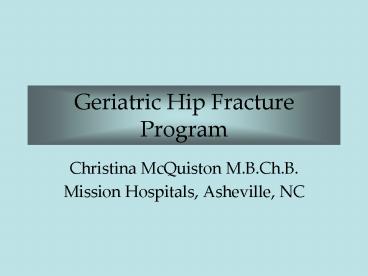Geriatric Hip Fracture Program - PowerPoint PPT Presentation
1 / 20
Title:
Geriatric Hip Fracture Program
Description:
olecranon bursitis . periprosthetc osteolysi . periprosthetc fx-pros j . keratoconjunctivitis no . malign neopl breast nec . crbl art oc nos wo infr . dmi neuro nt st ... – PowerPoint PPT presentation
Number of Views:101
Avg rating:3.0/5.0
Title: Geriatric Hip Fracture Program
1
Geriatric Hip Fracture Program
- Christina McQuiston M.B.Ch.B.
- Mission Hospitals, Asheville, NC
2
The Problem
- 300,000 Americans experience a hip fracture
annually - In 2005 fragility fractures cost around 19
billion - By 2025 it is predicted that these costs will
rise to around 25billion. - Around 24 of such patients over 50 will die in
the year following a fracture
3
Hip Fracture Repair per 1,000 Medicare Enrollees
(2003)
National Average 7.53
1. Oklahoma 9.06
2. Tennessee 8.87
3. Georgia 8.78
3. North Carolina 8.78
11. South Carolina 8.28
23. Florida 7.46
Source Dartmouth Atlas 2003
4
Hip Fracture Repairs NC Hospitals
Medicare volumes
5
Mission Hospitals All payers
2006 2007
Total number 586 563
Total number over age 64 492 454
ALOS all pts 5.8 days 6.36 days
6
Mission Hospitals Net income per Case
7
Environmental Survey
- Reviewed literature on co-management models.
Shows decreased LOS and readmissions. - Reviewed anesthesia literature. Less delirium
with spinal anesthesia. - Reviewed and incorporated CHEST guidelines for
VTE prophylaxis. - Reviewed orthopedic literature regarding post hip
fracture weight bearing status. - Reviewed current recommendations for osteoporosis
treatment. - Site visit to Highland hospital in Rochester NY
to review their process. (data published this
summer)
8
Plan Outline
- All patients with fragility hip fractures(gt65yr)
- Orthopedist remains attending physician.
- All patients co-managed by hospitalist.
- Elder specific pre and post op order sets.
- Consistent early weight bearing.
- Chest guidelines for VTE prophylaxis.
- Incorporate osteoporosis treatment.
9
Current Work
- Improve collaboration among ER physicians,
orthopedists, hospitalists and anesthesiologists. - Develop a protocol driven medical co-management
process. - Streamline throughput from admission to
discharge. - Create elder specific computerized power plans.
10
Medical Co-Management
- Standardize the initial medical consult with
attention to geriatric syndromes. - Accurately document medical co-morbidities.
- Stratify risk.
- Coordinate additional consults.
- Actively manage the discharge process.
11
Everyone Wins
- Door to OR in lt24 hrs.
- Reduce length of stay.(4 day goal)
- Reduce costs.
- Reduce complications.
- Reduce hospital acquired delirium.
- Reduce readmissions.
- Increase patient and family satisfaction.
12
Door to OR data
13
Readmission-Reasons 46 Patients
Anemia 1
Aspiration Pneumonia 1
Atrial Fibrillation 3
C Diff Colitis 2
CHF 2
Cholelithiasis 1
Dehydration 3
Dysphagia 1
Fever 1
Gangrene non-operative leg 1
GI bleed 1
Hip dislocation 7
HTN 1
Ileus 1
Lag screw cut femoral head 1
Nausea 2
New fracture 9
Non-union 1
Pain 1
Pancreatitis 1
Pneumonia 6
Septic Shock 2
Thrombus 1
UTI 3
Wound Erythema 2
Wound Infection 6
Readmissions
Readmissions Timing 46 Patients
Returned within 7 days 16
Returned between 8-14 days 12
Returned between 15-21 days 8
Returned between 22-31 days 10
APR DRG Cases APR Readmission Rate Expected APR Readmission Rate Expected APR Readmission Rate Index
308 418 7.56 10.45 0.76
309 51 9.80 10.93 0.74
14
Barriers
- Hospitalists fears over scope creep
- Surgical outliers regarding delays from admission
to OR - Inter-hospital transfers (we have 2 campuses)
- OR availability
- Weekend discharges to rehabilitation facilities
- Medicare part A reimbursement for SNF care and
VTE prophylaxis.( Coumadin vs Arixtra/lovenox)
15
Facilitators
- Administrative advocate
- Support from orthopedic service line leader
- Access to data collection and statistician.
- Enthusiastic and supportive nursing staff.
16
Time Line
- October 2008 . Turn on geriatric specific pre and
post op order sets. - November . Formalize agreement with hospitalists.
- January. Roll out new discharge process.
- February. Incorporate delirium prevention and
management and the HELP program.
17
Year 2
- Work with SNFs on post hip fracture care.
- Develop out patient falls prevention program with
community partners. - Develop osteoporosis management strategy for
SNFs.
18
Delirium Task Force
- Develop standardized tools for documentation
(CAM) - Non pharmacological approaches to prevention and
management, - Streamline medication options for treatment.
- HELP pilot.
19
Long Term Goals
- To provide a best practice model for the
hospitalized older patient . - The hospitalist as geriatrician.
- To heighten visibility of Senior Services in my
institution. - Earn a place at the table for geriatrics
20
What Ive Learned
- A prophet is not without honor except in his or
her own country. - That and the importance of data to administrative
support.































